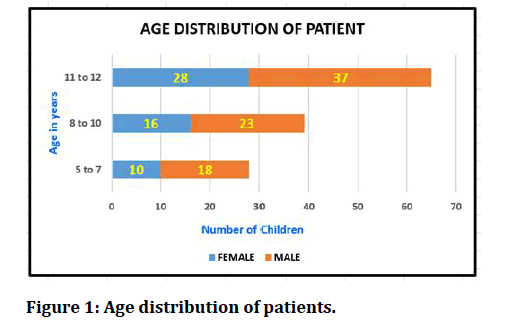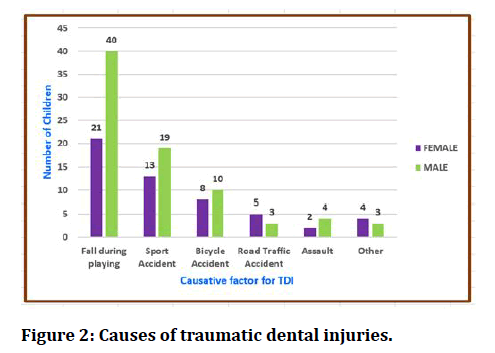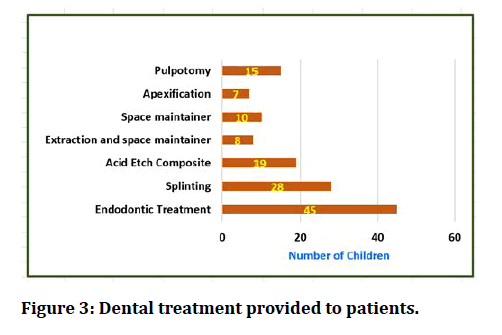Research - (2021) Volume 9, Issue 10
Retrospective Analysis of Traumatic Dental Injuries in Saudi Children: An Institutional Study
M Zakirulla1*, Turki M Al-Shehri2, Dhafer Ali Alasmari2, Mohammed S Alalyani2, Turki A Alasmari2, Malak A Asiri2, Demah S Alharthi3, Nouf A Assiri4, Naif A Assiri4, Sami Mohammed A Al Awwadh4, Wajed T Alhamrani4, Faten A Alshahrani2, Mohammed H Alasmari2, Yasser M Alqahtani2 and Hafiz M Hakami2
*Correspondence: M Zakirulla, Department of Pediatric Dentistry and Orthodontic Sciences, College of Dentistry, King Khalid university, Saudi Arabia, Email:
Abstract
Aim: This study aimed to analyse data from the records of the past five years of Saudi children seen in the dental trauma emergency clinic in College of Dentistry King Khalid University, Abha, Saudi Arabia. Materials and Methods: The current study was a cross-sectional observational analytic study. Our study includes the records of children having age groups of 2 to 12 years who visited the Department of Pediatric Dentistry in the College of Dentistry King Khalid University, from January 2015 to December 2019 as a result of pediatric TDI. Trauma records were obtained based on the Andreasen and Andreasen classification (1). The clinical Information regarding (i) Age, (ii) Sex, (iii) Most affected teeth, (iv) Cause of injury (falls, impact against a hard object or collisions, traffic accident, sport, and game accident, abuse), (v) Monthly distribution of trauma, (vi) Type of trauma (9), (vii) Time elapsed following injury, and (viii) Treatment was recorded. The data were entered and analyzed using the Statistical Package for the Social Sciences (SPSS 20). A P-value of less than 0.05 was considered to be statistically significant. Results: The dental trauma records of patients with an average age of 8 years, including 54 girls (40.9%) and 78 boys (59.1%), were evaluated. The most common cause of trauma was falling (61%). Enamel/ Dentin fracture was the most common type of dental hard tissue fracture around 53 (40.1%). In the category of periodontal tissue injuries, intrusive luxation injury (12.1%) was the most common. Conclusions: Our research disclosed that boys were exposed to more traumatic injuries, and the most crucial factor in traumatic injuries is falling. Therefore, teachers, pediatricians, parents, and children should be cautioned about probable dangers and emergency treatments for all age groups on dental trauma.
Keywords
Prevalence, Radiographs, Children, Dental trauma, Saudi
Introduction
Traumatic dental injuries (TDI) causes the most significant harm to the dentition following dental care caries. Traumatic dental injuries often develop in children, and the ones in adults comprise 5% of all accidental injuries that need treatment [1]. The literature shows that 3%-80% of emergency dental therapy's are due to tooth injuries. The occurrence of dental trauma within 12 months is 0.4% in every generation and 1.3%-4% in school-age in young children. It's been documented that 25% of most school children experienced dental trauma, and 33% of grown-ups, generally at age 19, have observed injury within their permanent teeth [2]. Physical and psychological suffering after trauma, pain and other problems can provoke a tendency to avoid laughing and smiling, which may affect social associations, and contains been documented as part of the results that traumatized anterior teeth could cause [3]. Also, injury in primary teeth makes a difference in the growth of permanent dentition [4]. Individual communities need to evaluate data from their geographic regions so that specific tips about the management and prevention of TDIs can focus on the population's requirements [5]. This can better understand the environmental and behavioral factors that might perform a significant purpose in TDIs. Earlier prospective cross-sectional studies documented a prevalence of TDIs among 3- to 13-year-old Saudi children was 9.79% [6]. However, no previous retrospective study has researched TDIs among Saudi Arabian kids. This retrospective study's objective was to recognize the types, causes, treatment presented, along with other factors connected with permanent TDIs records of the past five years of Saudi children observed in the dental trauma emergency clinic in College of Dentistry King Khalid University, Abha, Saudi Arabia.
Material and Methods
The current study was a cross-sectional observational analytic study. Our study includes the records of children having age group of 2 to 12 years, who visited the Department of Pediatric Dentistry in the College of Dentistry King Khalid University, from January 2015 to December 2019 as a result of pediatric TDI. Ethical letter for carrying out the study was acquired from the Institutional review board (IRB/KKUCOD/ETH/2020-21/044) of the College of Dentistry, King Khalid University. Trauma records were obtained based on the Andreasen and Andreasen classification (1). The clinical Information regarding (i) Age, (ii) Sex, (iii) Most affected teeth, (iv) Cause of injury (falls, impact against a hard object or collisions, traffic accident, sport and game accident, abuse), (v) Monthly distribution of trauma, (vi) Type of trauma (9), (vii) Time elapsed following injury, and (viii) Treatment was recorded. The data were entered and analyzed using the Statistical Package for the Social Sciences (SPSS 20). The difference in the prevalence of supernumerary teeth between gender was assessed with the chi-square test (p < 0.05 significance level).
Results
The dental trauma records of patients with an average age of 8 years, including 54 girls (40.9%) and 78 boys (59.1%), were evaluated. The most common cause for trauma was falls (61%).
Enamel/ Dentin fracture was the most common type of dental hard tissue fracture around 53 (40.1%). In the category of periodontal tissue injuries, intrusive luxation injury (12.1%) was most common. Type of dental trauma according to gender was shown in Table 1. Age distribution was shown in Figure 1. Various causes of traumatic dental injuries in children was shown in Figure 2. Distribution of dental treatment provided to the children following dental trauma was shown in Figure 3.
Table 1: Type of dental trauma according to gender.
| Type of Dental Trauma | Female | Male | Total |
|---|---|---|---|
| Dental hard tissue and pulp injury | |||
| Enamel infraction | 1 (1.8%) | 0 (0%) | 1 (0.7%) |
| Enamel fracture | 3 (5.5%) | 5 (6.4 %) | 8 (6%) |
| Enamel/dentin fracture | 21 (38.8%) | 32 (41%) | 53 (40.1%) |
| Complicated crown fracture | 10 (18.5%) | 15 (19 .2%) | 25 (18.9 %) |
| Complicated crown-root fracture | 3 (5.5%) | 3 (3.8 %) | 6 (4.5 %) |
| Root fracture | 2 (3.7%) | 1 (1.2%) | 3 (2.27 %) |
| Periodontal tissue injury | |||
| Subluxation | 1 (1.8 %) | 5 (6.4%) | 6 (4.5 %) |
| Lateral luxation | 2 (3.7%) | 4 (5.1%) | 6 (4.5 %) |
| Intrusive luxation | 7 (12.9%) | 9 (11.5%) | 16 (12.1%) |
| Extrusive luxation | 0 (0 %) | 1 (1.2%) | 1 (0.7 %) |
| Avulsion | 4 (7.4 %) | 3 (3.8%) | 7 (5.3 %) |
| Total | 54 (100%) | 78(100%) | 132(100%) |

Figure 1: Age distribution of patients.

Figure 2: Causes of traumatic dental injuries.

Figure 3: Dental treatment provided to patients.
Discussion
Traumatic dental injuries are time-consuming and costly treatments, which are limitations to seeking treatment. Therefore, means of protecting against oral traumas are being developed. The aspects leading to trauma have to be fully understood when developing ways of preventing oral trauma. TDI treatment is standard in pediatric clinical practice and will be necessary for diagnosis and emergency care currently [7]. Consequently, the professional's information is essential when considering the radiographic, medical, and emotional elements involved. Retrospective studies are an effective method in providing information about how traumatic injuries occur and the underlying etiologic factors [8]. In this study, the incidence of teeth trauma was higher in children between 11 and 12 years, and in line with the results of Altun et al.,[9], more dental trauma occurred between the ages of 8 and 10 years. This may cause children in the 11-12 years old generation to take a lot more active role in social life, much like other research [10]. Falling was the most frequent reason behind dental trauma in both age groups. In addition, it's been noticed that game accidents occur more often in kids age 11-12 years than in 5‑ to 7-year-old children. This may end up being cause school-aged children begin to spend some time outdoors, and their play involves more physical contact.
Only 8% of patients attended the pediatric dental department within a day of the TDI, whereas 52% of children were seen after one month from injury. In Turkey, 19% to 35% of TDI children were seen on the injuries [11]. The delay in reporting the patients in this study is an indicator of the weak knowledge among parents and educators concerning the advantages of instant diagnosis and treatment of TDIs. Therefore, targeting the parents and schoolteachers through particular dental care trauma prevention programs may be beneficial. Furthermore, clear and simple informational campaigns through newspapers, television, brochures, and posters are useful ways to raise public awareness [12].
The most regular treatment for traumatized teeth Was endodontic (55%), similar to other studies [13]. Additionally, various pulp therapy methods (apexification, Cvek pulpotomy) were found in 22% of the cases. A complicated crown fracture was not the only cause for the beginning of pulp therapy. The delayed reporting of patients with enamel/dentin fracture and various luxation injuries may have detrimentally affected dental pulp tissue integrity, resulting in pulp therapy.
Traumatic dental injuries in children were evaluated based on the kind of injury in our research, and enamel-dentin fractures were determined to be encountered the most 53 (40.1%). When studies in literature were reviewed, it had been found that the regularity of crown fractures varied between 26% and 90% [14]. Dental injuries often have a minor impact on the oral soft tissues and teeth and on the periphery concerning the severity of the trauma. However, this is a serious issue that has a negative impact on patients concerning factors such as pain, function, aesthetics, and psychology. Intrusive luxation injuries about 16 (12.1%) had been typical among accidental injuries to the soft tissue of teeth tissues. The post-trauma harm to the primary teeth more frequently occurs in the peripheral supporting tissues (periodontal ligament and alveolar bone) than in the hard tissues of one's teeth due to the excessive flexibility of the tissues around the significant teeth and shortness of the primary tooth root. Therefore, it is noticed that an adverse impact on the principal tooth usually will cause luxation. In the trauma of the primary teeth, the procedure and prognosis of the trauma ought to be evaluated regarding the health of the permanent teeth because of the proximity to the underlying permanent dental germ [15].
While the findings of this research are in accordance with a number of researches in both the national and international literature [16], they disagree with others [17]. In these studies, the technique used could be considered a limitation, where a cross-sectional method could lead to undiagnosed lesions. For example, luxations are not recognized in most cases because there was no evidence of sequelae of the type of trauma when the survey had been undertaken. From the data shown in this study, it had been seen that suffered efforts must be made and health promotion policies drafted to prompt the implementation of preventive ways of reducing the prevalence of TDI in preschool children. Draft plans to take care of these injuries.
Conclusion
Our research disclosed that boys were exposed to more traumatic injuries, and the most crucial factor in traumatic injuries is falling. Therefore, teachers, pediatricians, parents, and children should be cautioned about probable dangers and emergency treatments for all age groups on dental trauma. Early treatment is important for the prognosis of the injured tooth, but the referral rate to the clinic after trauma was low except for severe injuries. The most frequent injury reported was enamel dentin fracture, and probably the most frequent treatment done was Endodontic therapy following trauma. This situation is an indicator of having less social consciousness. Therefore, the level of social awareness and understanding of trauma should end up being increased.
Conflicts of Interest
The authors declare that there is no conflict of interest regarding the publication of this article.
References
- Petersson EE, Andersson L, Sörensen S. Traumatic oral and nonoral injuries. Swed Dent J 1997; 21: 55-68.
- Glendor U. Epidemiology of traumatic dental injuries a 12 year review of the literature. Dent Traumatol 2008; 24:603-611.
- Marcenes W, Al Beiruti N, Tayfour D, et al. Epidemiology of traumatic injuries to the permanent incisors of 9â??12-year-old schoolchildren in Damascus, Syria. Endod Dent Traumatol 1999; 15:117â??123.
- Jorge KO, Moysses SJ, Ferreira e Ferreira E, et al. Prevalence and factors associated to dental trauma in infants 1â??3 years of age. Dent Traumatol 2009; 25:185â??189.
- Goettems ML, Torriani DD, Hallal PC, et al. Dental trauma: Prevalence and risk factors in schoolchildren. Community Dent Oral Epidemiol 2014; 42:581-590.
- Gupta M, Apathsakayan R, Abhishek. Traumatic Injuries to the anterior teeth among children of Jazan, Kingdom of Saudi Arabia: A screening study. World J Dent 2018; 9:192-196.
- Andreasen JO, Ravn JJ. Epidemiology of traumatic dental injuries to primary and permanent teeth in a Danish population sample. Int J Oral Surg 1972; 1:235-239.
- Zuhal K, Semra OE, Hüseyin K. Traumatic injuries of the permanent incisors in children in southern Turkey: A retrospective study. Dent Traumatol 2005; 21:20-25.
- Altun C, Ozen B, Esenlik E, et al. Traumatic injuries to permanent teeth in Turkish children, Ankara. Dent Traumatol 2009; 25:309-313.
- Atabek D, Alaçam A, Aydintug I, Konakoglu G. A retrospective study of traumatic dental injures. Dent Traumatol 2014; 30:154-61.
- Cem Gungor H, Uysal S, Altay N. A retrospective evaluation of crown-fractured permanent teeth treated in a pediatric dentistry clinic. Dent Traumatol 2007; 23:211-217.
- Bourguignon C, Sigurdsson A. Preventive strategies for traumatic dental injuries. Dent Clin North Am 2009; 53:729-749.
- Bastone EB, Freer TJ, McNamara JR. Epidemiology of dental trauma: A review of the literature. Aust Dent J 2000; 45:2â?? 9.
- Altay N, Güngör HC. A retrospective study of dento-alveolar injuries of children in Ankara, Turkey. Dent Traumatol 2001; 17:201-204.
- Kuscu Ã?Ã?, Sandalli N, Ã?aglar E. Dental trauma in children. Yeditepe Dis Hekimligi Dergisi 2011; 3:6-14.
- Skaare AB, Jacobsen I. Primary tooth injuries in Norwegian children (1-8 years). Dent Traumatol 2005; 21:315-319.
- Cunha RF, Pugliesi DM, Vieira AE. Oral trauma in Brazilian patients aged 0-3 years. Dent Traumatol 2001; 17:210-212.
Author Info
M Zakirulla1*, Turki M Al-Shehri2, Dhafer Ali Alasmari2, Mohammed S Alalyani2, Turki A Alasmari2, Malak A Asiri2, Demah S Alharthi3, Nouf A Assiri4, Naif A Assiri4, Sami Mohammed A Al Awwadh4, Wajed T Alhamrani4, Faten A Alshahrani2, Mohammed H Alasmari2, Yasser M Alqahtani2 and Hafiz M Hakami2
1Department of Pediatric Dentistry and Orthodontic Sciences, College of Dentistry, King Khalid university, Abha, Saudi Arabia2Intern, College of Dentistry, King Khalid university, Abha, Saudi Arabia
3Dental Student, College of Dentistry, King Khalid university, Abha, Saudi Arabia
4General Dentist, Private Clinic, Abha, Saudi Arabia
Citation: M Zakirulla, Turki M Al-Shehri, Dhafer Ali Alasmari, Mohammed S Alalyani, Turki A Alasmari, Malak A Asiri, Demah S Alharthi, Nouf A Assiri, Naif A Assiri, Sami Mohammed A Al Awwadh, Wajed T Alhamrani, Faten A Alshahrani, Atheer M Asiri, Norah Ali Alqahtani, Roaa Ali Alqahtani, Mohammed H Alasmari, Yasser M Alqahtani, Hafiz M Hakami,Retrospective Analysis of Traumatic Dental Injuries in Saudi Children: An Institutional Study, J Res Med Dent Sci, 2021, 9(10): 59-62
Received: 07-Sep-2021 Accepted: 27-Sep-2021
